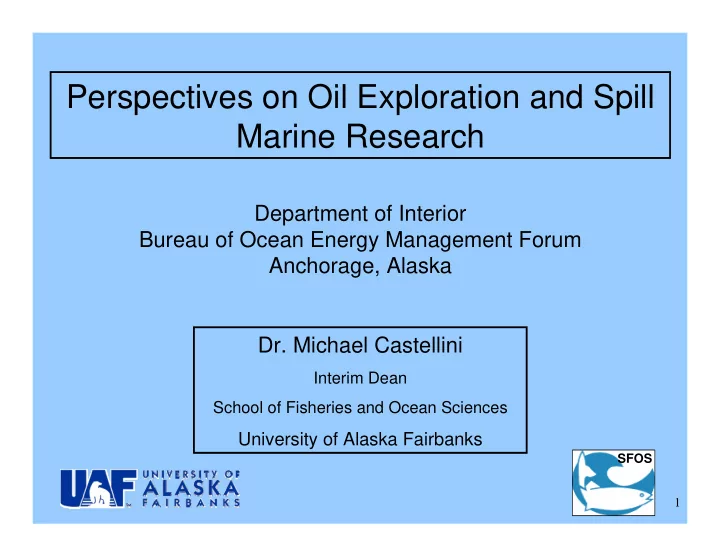

Perspectives on Oil Exploration and Spill Marine Research Department of Interior Bureau of Ocean Energy Management Forum Anchorage, Alaska Dr. Michael Castellini Interim Dean School of Fisheries and Ocean Sciences University of Alaska Fairbanks SFOS 1
How balance exploration, economics, environmental / social impact and risk in Alaska? Themes for today: What is the role of marine science research in this equation? What did we learn from Exxon Valdez Oil Spill? How can we improve in the future? 2
Role of marine research for environment ( Not engineering / safety development ) Before vs After • • Where would oil move? • Impact to ecosystems 3
Before vs After (Concept of Environmental Assessment of the Alaska Continental Shelf in late 1970’s) 1.The most important finding from EVOS 2.Requires assessing stress points 3.Environmental Studies Program (MMS) and Coastal Marine Institutes Recommendation: Minimize snapshots ‐ enhance monitoring 4
Where would oil move? 1.Surface currents / winds 2. Mid ‐ water and deep currents 3.At least Alaska shelf is shallow 4.Alaska: With or without ice 5.Extreme temperatures, darkness 6.Alaska logistics <<< GOM 5
Two radar sites yield hourly, realtime surface currents Applications: ecosystem studies (habitat, circulation, model guidance) oil spill response planning and response guidance Radar 1 Radar 2 6
Radar Installations are Presently Limited by Access to Shoreside AC Power unavailable throughout most of coastal Alaska The Remote Power Module: 1.Power from wind & solar; battery bank and backup bio-diesel generator 2.Modular (portable) for transport to remote sites by small vehicles 3.“Arctic-hardened” for long-term installation 4.Monitored via satellite communications 5.Optimizes Radar Coastal Site Selection 7
Oceanographic Moorings: Deployed for one year & recording hourly: Currents, temperature, salinity, chlorophyll, marine mammal sounds, nitrate, turbidity, etc. 38 m 1 m 8
2010 Marine Mooring Locations in the Chukchi Sea supported by: DOI ‐ BOEMR, ConocoPhillips, Shell, StatOil, NSF, NOAA, Japan Marine Mammal Recorders Surface Current Radar Mask Oceanographic Moorings 9
Autonomous Underwater Vehicles (AUV) or gliders Zig ‐ zags through water column making measurements. Transmits data every 6 ‐ hours via Iridium. New waypoints transmitted during its mission 10
Ecosystem Assessment 1.Physical aspects of exploration • noise, disturbance 2.Physical aspects of oil • gill fouling; insulation failure 3.Chemical aspects of oil • Short term vs long term 11
What is the balance….how do we improve? If could start over, what would we do differently on the science side? 1.Environmental studies become gateways 2.Litigation does not equal science design 3.Employ NSF level science program 4.Enhance social studies 5.Stress value decisions 12
Recommend
More recommend